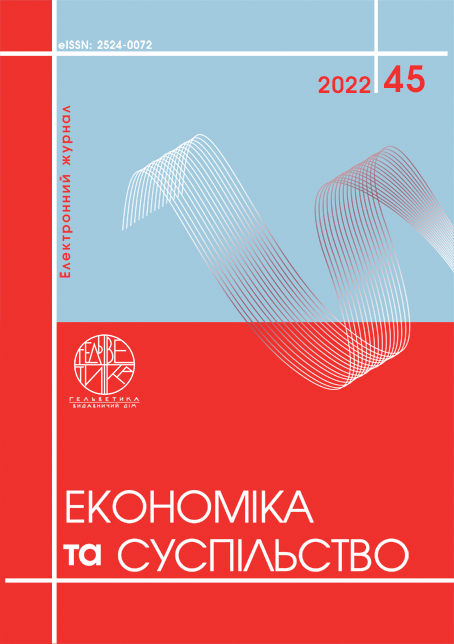THEORETICAL FOUNDATIONS OF ENVIRONMENTAL RISK MANAGEMENT IN THE CONTEXT OF TRANSITION TO A «GREEN» ECONOMY
Abstract
In recent years, businesses around the world have begun to pay more attention to environmental issues, and environmental innovation is essential to balance economic growth and environmental sustainability. The activity of any industrial enterprise affects the environment, and most often this impact is negative. At the same time, in the conditions of constant growth of man-made influence, the environmental requirements of consumers are also increasing, the requirements of state regulatory bodies are increasing, and the public's awareness of environmental protection issues is increasing. This, in turn, creates a large number of environmental risks. To increase their sustainability and ensure environmental safety, enterprises are forced to analyze these risks in order to manage them and develop countermeasures. Therefore, the relevance of the chosen work topic is determined by the need to analyze environmental risks that arise during the functioning of modern enterprises in the conditions of the "green economy". The purpose of the article is to study the theoretical provisions and principles of environmental risk management, to study the concept of "environmental risk" and types of environmental risks in the context of the transition to a "green" economy. The article defines theoretical approaches to the interpretation of the essence of environmental risks, provides a classification of environmental risks for modern enterprises, presents the sources and factors of environmental risk. The article contains a detailed analysis of the stages of the risk management process, a study of the trends of the world "green" economy and the prerequisites for the need for environmental risk management. It is shown that in order to understand how to solve problems related to environmental risks, it is necessary to study the interaction of the enterprise with the environment in such areas as resource provision, production and sale of products. As a conclusion, it is stated that the management of the enterprise should pay increased attention to external and internal factors that can cause environmental risks. In addition, the new model of socially responsible investment involves business awareness of its impact on the environment and society.
References
Smith A. An Inquiry into the Nature and Causes of the Wealth of Nations (1976). The Glasgow edition of the works and correspondence of Adam Smith. 1776. Т. 2.
Malthus T. R. An essay on the principle of population (1798). The Works of Thomas Robert Malthus, London, Pickering & Chatto Publishers. 1986. Т. 1. P. 1-139.
FTSE Russel Report. Overtaking Fossil Fuel Industry. 08 June 2018. URL: https://unfccc.int/news/green-economy-overtaking-fossil-fuel-industry-ftse-russel-report (дата звернення: 30.11.2022).
Environmental economy – statistics by Member State. Eurostat Statistic Explained. URL: https://ec.europa.eu/eurostat/statistics-explained/index.php?title=Environmental_goods_and_services_sector&oldid=61204/ (дата звернення: 07.12.2022).
Джусов О.А., Красніков П.Д. Роль ринків відновлюваної енергетики у вирішенні глобальних проблем сучасності. Економічний простір: Збірник наукових праць. № 150. Дніпро: ПДАБА. 2019. C. 194–209.
Джусов О. А., Краснікова Н. О., Бененсон О. О. Дослідження інвестиційного потенціалу акцій компаній циркулярного бізнесу. Економічний простір: Збірник наукових праць. № 172. Дніпро: ПДАБА. 2021. C. 29–34.
S. K. Chaulya, G. M. Prasad. Sensing and Monitoring Technologies for Mines and Hazardous Areas. Elsevier. 2016. 403 p.
V. Ustohalova. Encyclopedia of Environmental Health. Elsevier. 2011.
Ілляшенко С. М., Божкова В. В. Екологічні ризики інновацій: Класифікація та аналіз. Фінанси України. 2005. № 1. С. 49–59.
Семенова С. М. Класифікація ризиків: систематизований підхід з метою управління. Вісник Хмельницького національного університету. Серія: Економічні науки. 2020. Вип. № 4(2). С. 42–51.
Тиркало Ю. Є. Оптимізація управлінських рішень в умовах підприємницького ризику і невизначеності. Міжнародний науковий журнал «Інтернаука». 2022. Вип. № 3. С. 12–16.
Трикоз І. В., Саранов В. В., Саранов В. Ф. Удосконалення управління господарськими ризиками підприємства. Вісник Бердянського університету менеджменту і бізнесу. 2021. № 1. С. 78–83.
Smith A. An Inquiry into the Nature and Causes of the Wealth of Nations (1976). The Glasgow edition of the works and correspondence of Adam Smith. 1776. Т. 2.
Malthus T. R. An essay on the principle of population (1798). The Works of Thomas Robert Malthus, London, Pickering & Chatto Publishers. 1986. Т. 1. P. 1–139.
FTSE Russel Report. Overtaking Fossil Fuel Industry. 08 June 2018. Retrieved from: https://unfccc.int/news/green-economy-overtaking-fossil-fuel-industry-ftse-russel-report.
Environmental economy – statistics by Member State. Eurostat Statistic Explained. Retrieved from: https://ec.europa.eu/eurostat/statistics-explained/index.php?title=Environmental_goods_and_services_sector&oldid=61204/.
Dzhusov O. A., Krasnikov P. D. (2019) Rol' rynkiv vidnovliuvanoi enerhetyky u vyrishenni hlobal'nykh problem suchasnosti [The role of renewable energy markets in solving contemporary global problems]. Ekonomichnyj prostir: Zbirnyk naukovykh prats'. № 150. Dnipro: PDABA. pp. 194–209.
Dzhusov O. A., Krasnikova N. O., Benenson O. O. (2021) Doslidzhennia investytsijnoho potentsialu aktsij kompanij tsyrkuliarnoho biznesu [Investigating the investment potential of shares of circular business companies]. Ekonomichnyj prostir: Zbirnyk naukovykh prats'. № 172. Dnipro: PDABA. pp. 29–34.
S. K. Chaulya, G. M. Prasad. (2016) Sensing and Monitoring Technologies for Mines and Hazardous Areas. Elsevier. 403 p.
V. Ustohalova (2011). Encyclopedia of Environmental Health. Elsevier.
Illiashenko S. M., Bozhkova V. V. (2005) Ekolohichni ryzyky innovatsij: Klasyfikatsiia ta analiz [Environmental risks of innovation: Classification and analysis]. Finansy Ukrainy. № 1, pp. 49–59.
Semenova S. M. (2020) Klasyfikatsiia ryzykiv: systematyzovanyj pidkhid z metoiu upravlinnia [Risk classification: a systematic approach for the purpose of management]. Visnyk Khmel'nyts'koho natsional'noho universytetu. Seriia: Ekonomichni nauky. № 4(2), pp. 42–51.
Tyrkalo Yu. Ye. (2022) Optymizatsiia upravlins'kykh rishen' v umovakh pidpryiemnyts'koho ryzyku i nevyznachenosti [Optimization of management decisions in conditions of entrepreneurial risk and uncertainty]. Mizhnarodnyj naukovyj zhurnal «Internauka». № 3, pp. 12–16.
Trykoz I. V., Saranov V. V., Saranov V. F. (2021) Udoskonalennia upravlinnia hospodars'kymy ryzykamy pidpryiemstva [Improvement of enterprise economic risk management]. Visnyk Berdians'koho universytetu menedzhmentu i biznesu. № 1, pp. 78–83.


